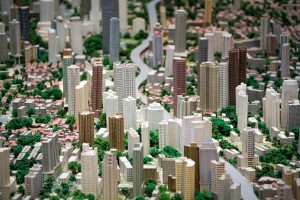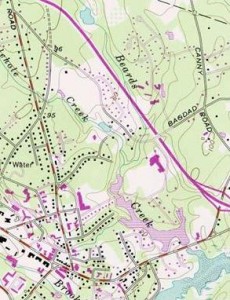Carving Out the Landscape
TeachEngineering.org lesson contributed by the Integrated Teaching and Learning Program, College of Engineering, University of Colorado Boulder.
Summary
In this activity, students investigate major landforms (e.g., mountains, rivers, plains, hills, oceans and plateaus) in groups of two. They build a three-dimensional model of a landscape depicting several of these landforms. Once they have built their model, they act as civil and transportation engineers to build a road through the landscape they have created.
Grade Level: 3-5
Time: 100 minutes (Two 50-minute periods)
Expendable Cost/Group: US$0.50
Group Size: 2
Engineering Connection
After this activity, students should be able to:
- Identify the major features of the Earth’s surface such as mountains, rivers, plains, canyons and plateaus.
- Describe how engineers need knowledge of landforms for designing transportation systems.
- Explain why engineers build a model before a final project.
- Develop a model to represent the shapes and kinds of land and bodies of water in an area. [Grade 2]
- Define a simple design problem reflecting a need or a want that includes specified criteria for success and constraints on materials, time, or cost. [Grades 3 – 5]
- E. Models are used to communicate and test design ideas and processes. [Grades 3 – 5]
- D. The use of transportation allows people and goods to be moved from place to place. [Grades 3 – 5]
Materials List
Each group needs:
- 2 feet by 2 feet square of cardboard
- 2 copies of the Winding Road Worksheet
To share with the entire class:
- Various colors of construction paper
- Colored markers and/or paint
- Cotton balls for the tops of mountains
- Popsicle sticks for making bridges
- Paper Mache or clay for creating landforms
- Scissors
- Glue
- Tape
Introduction/Motivation
Who’s driven on a road before? Is there a road that is near our school? Well, who builds those roads? Did you know that engineers usually build the roads that connect our communities? Have you ever driven through a tunnel? Do you know how that tunnel was built? Who built it? Again, engineers built it! How did they know where to put that tunnel? How do engineers determine where to build the roads? We are going to learn more about that today.
The landscape of the Earth is very different from place to place. Have you been somewhere that looks very different from here — maybe to the top of a mountain, on the ocean or someplace where the land is very flat? What different kinds of landscapes do you know about? (List the landforms they answer on the board.) Tell me about the landscape around our school.
There are different types of landforms that make up the landscape around us. Can you picture what each of these look like? (Point to the ones that the students already listed during this explanation and add any landforms that the students did not name to the list as you go through them. To help with the explanations, show the students any available pictures of the types of landforms.) Well, hills are a raised mound of land, and they can be small or large. Mountains are very tall places on Earth, much higher than a hill. Plateaus are just like mountains, except they have large, flat tops. Plains are flat lands that have only small changes in elevation — almost no hills there! An ocean is a large body of salt water that surrounds a continent, and a river is the moving body of water that usually empties into that ocean. What else? Well, a valley is a low point in the Earth’s surface, usually between ranges of hills or mountains, and a canyon is a deep narrow valley with steep sides that usually has a stream flowing through it. See, there are so many types of landforms that change the surface of the Earth!
Now, how do engineers know where to build roads, tunnels and bridges across these landforms? They know because geologists have studied the landscape and its composition. Geotechnical engineers study the different rocks and soils of the Earth and work with civil and transportation engineers to build roads, highways and train tracks to provide safe places for travel. Can you imagine if a tunnel collapsed, or if a road fell off the edge of a mountainside? This rarely happens because engineers have studied and understand the landforms that they are building on to make sure the roads and tunnels are safe. They decide if it is safe to build a road, bridge or tunnel there, and then decide how strong a material to use to build it. Often, engineers build a model of a transportation system before they build the real thing. This helps them explain to other people, like citizens and city planners, why a road or tunnel is in the right place. In this activity, you get to act like engineers and build a model of a landscape and decide the best place to put a road across your model. Are you ready?
Procedure
Before the Activity
- Gather supplies and make copies of the Winding Road Worksheet.
With the Students
Day 1
- Explain to students that they will be creating a landscape of their choosing out of a variety of materials. Give the students guidelines for the landforms that their model must include (all models should include a body of water and a mountain). For example: at least one mountain, a river, a large body of water, and two hills. The body of water should take up approximately a quarter of the space on their cardboard (6 inches by 6 inches). The mountain should be at least 4 inches in diameter.
- Make a list or T-chart of the required landforms on the board. Next to each landform, have the class brainstorm materials to use for creating each landform from what is available.
- Have students design a plan for their landscape. They should list the landforms that they will have and what materials they will use to build them on their worksheet.
- Have students build their landscape and leave them overnight to dry.
Day 2
- Once students have built their landscape, have them draw a picture of it on their worksheet.
- Next, tell students that they are going to be civil engineers who need to build a road through their landscape for a new community that is moving there. Tell the students that their road must go from one corner of the model to the other. Have students draw on their picture where they are going to put their road. Remind students that they might have to build a bridge over a river, if there is one where the road is going.
- Have students add their road(s) to the model using black paper and their bridge(s) using Popsicle sticks.
- When all students are finished, have each group show their model and explain why they put their road(s) where they did to the rest of the class.
Attachments
Winding Road Worksheet (English .doc)
Winding Road Worksheet (English .pdf)
Winding Road Worksheet (Spanish .doc)
Winding Road Worksheet (Spanish .pdf)
Troubleshooting Tips
Sometimes it is helpful to have a model built ahead of time to show the students. If you have built a model, do not put a road running through it. You want to prevent students from copying your model all together.
Students may have problems building tunnels through the mountains in their landscape. If they do, have them indicate the tunnel on their mountain by having their road lead up to the mountain, color a black mark for the tunnel entrance and exit, and then continue the road on the other side of the mountain.
If doing Paper Mache, it may also be difficult for students to build tunnels through their mountains. The teacher can use a utility knife and make the cuts for them. You would also want to make sure the students do not make their Paper Mache too thick.
Assessment
Pre-Activity Assessment
- Where do we find water?
- Where do we find land?
- What are some of the landforms on our Earth?
Activity Embedded Assessment
- How is a plateau different from a mountain? (Answer: Plateaus are elevated flat surfaces, while mountains typically come to a point or peak.)
- How is ocean water different from river water? (Answer: Ocean water is very salty; river water usually is not as salty as the ocean.)
Post-Activity Assessment
- What kinds of landforms did you put in your model?
- What other landforms could you add to your model?
- Why do you think is it important for engineers to build models?
Activity Extensions
Challenge the students to create a landscape that fits next to one or more other teams, maybe even the whole class. How might two or more engineering teams work together to design the roads and communities that cover their landscape(s)?
Have students think about the challenge of designing transportation that does not use a lot of fuel or energy around existing Earth landforms and create a design for a whole new futuristic city. Or have them describe an alternative idea for energy-saving transportation around their own city. Some ideas for innovative energy-saving transportation might include: roller coasters everywhere, shape cities like a bowl and have tiny cars roll down the side of the bowl to the next destination, or design a way to have citizens hang glide to their next location.
Have older student look into bridge building. The US Military Academy at West Point has the following bridge designer website and contest with a good introduction into simple bridge building: LINK.
Activity Scaling
For upper grades, allow the students to be creative in designing their landscapes. Have students practice measuring when building their landscapes by requiring them to measure the length of their road and the size of their different landforms. They can include these measurements on their worksheets.
For lower grades, give students explicit directions on locations to place landforms and the sizes that they must be. Also, make a model for them to follow before they begin the activity.
References
U.S. Department of Agriculture, Natural Resource Conservation Service, New Hampshire Cooperative Salt Marsh Projects, Beard’s Creek, Durham, NH, USGS Topographical Map, accessed August 15, 2006. LINK
2006 West Point Bridge Design Contest, accessed August 15, 2006. LINK
Contributors
Sara Born, Malinda Schaefer Zarske, Janet Yowell
Copyright
© 2006 by Regents of the University of Colorado.
Supporting Program
Integrated Teaching and Learning Program, College of Engineering, University of Colorado Boulder
Acknowledgements
The contents of this digital library curriculum were developed under a grant from the Fund for the Improvement of Postsecondary Education (FIPSE), U.S. Department of Education and National Science Foundation GK-12 grant no. 0338326. However, these contents do not necessarily represent the policies of the Department of Education or National Science Foundation, and you should not assume endorsement by the federal government.
Filed under: Class Activities, For Teachers, Grades K-5, Grades K-5, Grades K-5, K-12 Outreach Programs, Lesson Plans
Tags: activity, Civil Engineering, Geography, Landforms, Paper Mache, Transportation











